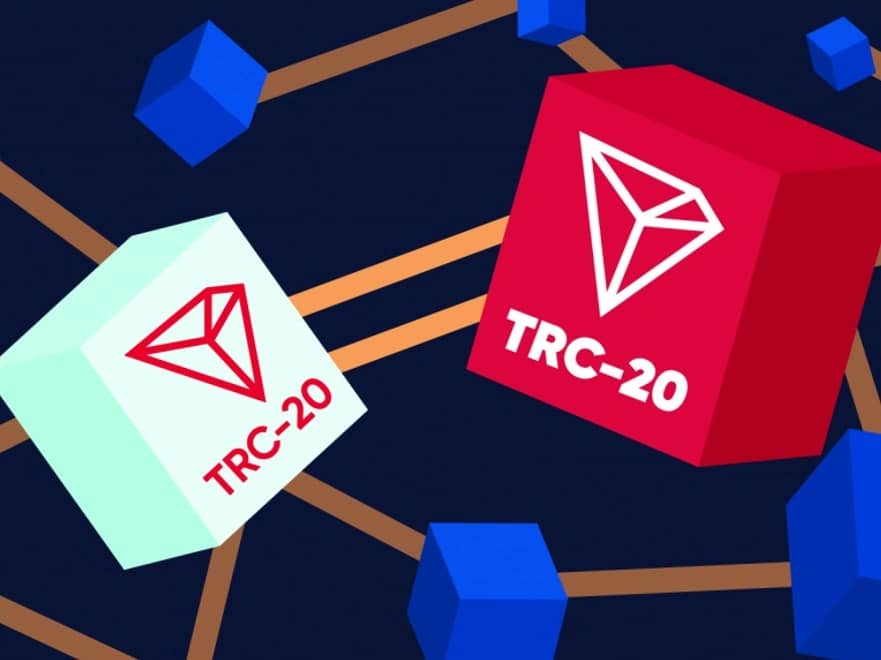订阅 wiki
Share wiki
Bookmark
TRC-20
TRC-20
TRC-20 是一种代币标准,旨在用于在 TRON 区块链 上部署 智能合约 以创建代币。它确保了 TRON 生态系统内的兼容性,为开发者构建和管理他们的代币提供了一个框架。[1][4][5]
概述
TRC-20是一种在TRON 区块链上使用的技术标准,用于创建和实施智能合约和可替代代币,以管理代币的发行和管理。TRC-20类似于ERC-20(以太坊征求意见稿20),后者是以太坊区块链上最流行的代币标准,但它被设计为仅在TRON区块链上运行,并且只能通过桥梁转移到另一个区块链网络。TRC-20代币是在TRON区块链上构建的数字资产,使用户能够安全透明地表示、转移和存储价值。[3][7][8][9]
为了促进在其平台上创建和管理数字资产,TRON有几个代币标准。这些标准定义了代币必须遵守的规则和功能,以便在TRON生态系统中无缝交互。以下是一些值得注意的TRON代币标准:[2]
- TRC-10: TRON区块链上的基本代币标准,促进TRON生态系统中数字资产的创建和转移。
- TRC-20: 使用智能合约的高级代币标准,提供更大的灵活性。
- TRC-721: 用于唯一数字资产的非同质化代币 (NFT)标准。
- TRC-1155: 多代币标准,在一个合约中支持同质化和非同质化代币。
特点
TRC-20代币充分利用了TRON虚拟机(TVM)的全部功能,强调高效、安全和可扩展的交易。该标准支持复杂的智能合约功能,包括代币转移和与其他合约的交互。以下是TRC-20的主要特点。
- 与TRON虚拟机(TVM)兼容: 与TVM无缝集成以执行智能合约。
- 高效的交易处理: 相比其他标准,针对更快的交易速度和更高的吞吐量进行了优化。
- 智能合约功能: 允许创建复杂的智能合约来执行各种操作,包括多方交互和自动交易。
- 代币互操作性: 确保TRC-20代币可以轻松地与TRON生态系统中的其他代币和应用程序进行交互。
- 能源和带宽系统: 利用独特的能源和带宽系统,降低交易和智能合约执行的成本。
优点
- 更低的交易成本: 由于TRON网络高效的能源和带宽系统,费用显著降低。
- 高交易速度: 能够更快地处理交易,使其成为需要高吞吐量应用的理想选择。
- 强大的安全性: 构建在安全且去中心化的TRON区块链上,为交易和智能合约执行提供高安全性。
- 在TRON生态系统中得到广泛采用: 在TRON社区中得到广泛使用,为各种dApp和服务提供强大的支持和无缝集成。
缺点
- 特定于网络: 仅限于TRON区块链,该区块链的采用可能不如以太坊广泛,这可能会限制与其他区块链上的应用程序的互操作性。
- 可变的网络性能: 依赖于TRON网络的整体性能,该性能可能会因网络拥塞和其他因素而异。
- 学习曲线: TRON生态系统的新开发人员可能需要时间来熟悉其独特的功能。
TRC-20代币开发的关键组成部分
智能合约开发
TRC-20代币是在波场区块链上作为智能合约实现的,使用Solidity或其他兼容的编程语言编写。开发者在智能合约代码中定义代币的属性,如名称、符号、总供应量和小数精度。
代币部署
智能合约代码编写和测试完成后,开发者使用TronBox、TronWeb或Truffle Suite等工具将代币合约部署到TRON区块链上。部署涉及与TRON的网络基础设施交互,并将合约部署到指定的地址。
代币配置
部署后,开发者可以配置代币的其他参数,例如初始供应分配、铸造和销毁能力以及访问控制机制。这些配置通常通过智能合约函数进行管理,并且可以根据需要进行更新。
与钱包和交易所集成
为了使用户能够与TRC-20代币交互,开发人员将代币功能集成到兼容的钱包和去中心化交易所(DEX)中。这种集成包括实施用于代币转移、余额和批准的标准接口,确保不同平台之间的无缝互操作性。
安全注意事项
在TRC-20代币开发中,安全性非常重要,开发者必须遵循最佳实践来降低代码漏洞、恶意攻击和未经授权的访问等风险。为了确保代币生态系统的安全,必须对智能合约代码进行审计,实施访问控制,并执行适当的身份验证方法。[6]
TRC-20 vs. ERC-20 的比较
技术差异
一个关键的区别是地址样式。以太坊地址以“0x”开头,而波场地址通常以“T”开头。TRC-20代币通常比ERC-20代币更快,因为波场网络比以太坊具有更高的每秒交易量(TPS)和更低的费用,这得益于委托权益证明共识机制。 至于代币设置,相似之处多于差异。两者在代币名称、符号和十进制精度方面都有相同的可选选择。强制性字段也相似。[10]
TRC-20 相对于 ERC-20 的优势
Tron 网络当然没有以太坊网络那样广泛的影响力,但它确实有一些优势,即低交易成本、高交易速度和高可扩展性。这三个关键要素使 TRC-20 代币在使用方面更具优势。虽然新想法在以太坊上推出,但这些想法的实际成功不仅来自以太坊网络的使用量,还来自它在包括 Tron 在内的其他网络上的复制和推出速度。
一个很好的例子是 DeFi 领域。它始于以太坊,但已迅速扩展到其他网络,以至于每个有价值的区块链都有一个像 Uniswap 这样的 DEX,一个像 AAVE 这样的借贷平台,以及一个像 OpenSea 这样的 NFT 市场。所有这些都可以在 Tron 上找到,成功程度各不相同,尤其是 JustLend 和 USDT 转移活动。[10]
局限性和缺点
- 无法直接交互:EVM 和 TVM 之间的不兼容意味着这些代币在没有经过某种转换过程的情况下无法转移到彼此的网络。这通常被称为桥,将在本文中进一步讨论。
- 智能合约漏洞:智能合约的复杂性使得它们容易出现编码错误或黑客试图利用现有代码。频繁的审计和检查对于确保合约尽可能稳固是必要的。
- 网络钓鱼和诈骗:假代币在两个网络上都很猖獗,可能在以太坊网络上更为严重,因为其中有更多的 ERC-20 代币。然而,这种现象是用户在与网络交互时需要警惕的事情。[10]
用例和应用
TRC-20代币标准已在加密货币领域的各种应用中得到采用,包括:[8]
- 实用代币: 许多项目创建实用代币作为访问和利用其dApps中特定服务或功能的手段。这些实用代币通常作为TRC-20代币发行,从而可以与TRON生态系统无缝集成。
- 首次代币发行(ICO): 创业者和初创公司可以利用TRC-20进行ICO,通过向早期投资者发行代币来为其项目筹集资金。
- 去中心化交易所(DEX): TRC-20代币可以在去中心化交易所上进行交易,从而为用户提供TRON网络内无缝且安全的交易体验。
- 游戏和娱乐: 游戏行业对TRC-20代币表现出极大的兴趣,因为它们可以用来奖励玩家并创建游戏内资产,从而在游戏中培育数字所有权和价值转移的新时代。
- 稳定币: 一些项目已经开发了基于TRC-20的稳定币,旨在维持价格稳定并促进TRON生态系统内的平稳交易。
支持 TRC-20 代币的钱包
各种钱包支持 TRC-20 代币,为用户提供安全存储、管理和交易这些代币的能力。 一些流行的支持 TRC-20 代币的钱包包括:[9]
- TronLink: Tronlink 是 TRON 区块链的官方冷钱包,为超过 90% 的 TRON 用户提供服务。 它允许与 TRON 区块链交互,包括管理 TRC-20 代币和访问去中心化应用程序。
- Trust Wallet: Trust Wallet 是一种多加密货币钱包,支持各种数字资产,包括 TRC-20 代币。 Trust Wallet 作为适用于 iOS 和 Android 设备的移动应用程序提供,为用户提供安全直观的界面来管理他们的代币。
- Ledger Wallet: Ledger 硬件钱包,例如 Ledger Nano S 和 Ledger Nano X,支持 TRC-20 代币。 用户可以使用 Ledger Live 软件管理他们的代币,该软件提供了一个用户友好的界面,用于安全地与 TRON 区块链交互。
- Coinbase Wallet: Coinbase Wallet 是一种自我托管钱包,允许用户存储、发送和接收 TRC-20 代币。 它作为适用于 iOS 和 Android 设备的移动应用程序提供,使用户可以控制其私钥和资产。
发现错误了吗?
